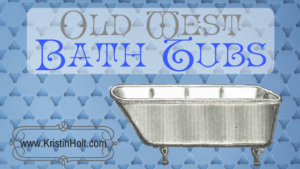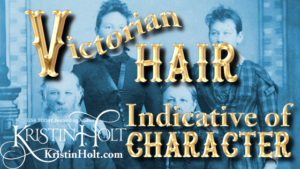Old West Barber Shop
Old West Barber Shop
.
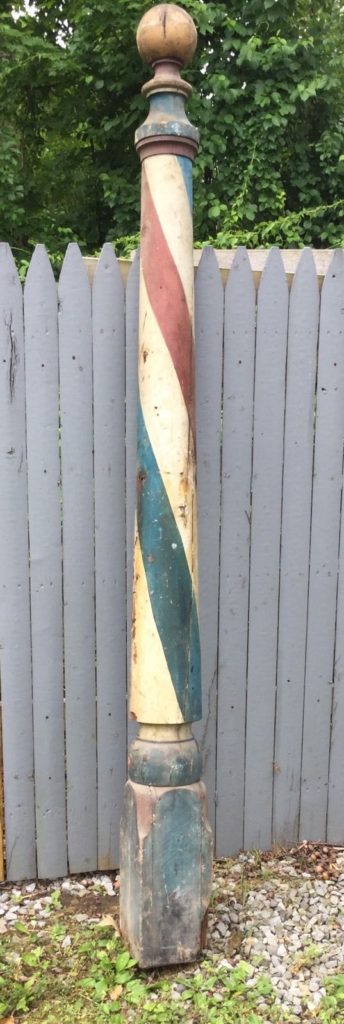
Antique 19th Century barber pole, currently for sale on eBay.
.
Sign of the Barber Pole
.
A barber’s pole is a type of sign used by barbers to signify the place or shop where they perform their craft. The trade sign is, by a tradition dating back to the Middle Ages, a staff or pole with a helix of colored stripes (often red and white in many countries, but usually red, white, and blue in the United States). [source]
.

Old Wooden Barber Pole. Image: Pinterest.
.
The standard symbol of a striped pole to alert passersby to the purpose of the shop was generated from general illiteracy of the Middle Ages. Even as the Victorian Era (with very high literacy rates) brought Euro-Americans west in North America, the symbol and “sign” persisted and remained a common fixture into the early- to mid-twentieth century.
.
Because of the general illiteracy of the populace, early store owners used descriptive emblems or figures to advertise their shops’ wares; for example, barber poles advertise barber shops, show globes advertised apothecaries and the three gold balls represent pawn shops. [source]
.

Vintage barber shop pole. Base reads: Martin The Hair cutter, Wig Maker,… Image: Pinterest.
.
Victorian-era Old West Barber Advertisements
.
Barbers in the American Old West offered a variety of services, including shaves and hair cuts.
.

Atchison Daily Patriot of Atchison, Kansas on July 25, 1870.
.

The Leavenworth Times of Leavenworth, Kansas, on March 30, 1870.
.

The Daily Kansas Tribune of Lawrence, Kansas on January 5, 1870.
.
In addition, your barber might “clean” your hair. Cleansing didn’t always involve a washing, at least not with water and soap.
.

Harry Frazier advertises his barber shop, including “Hair Cut, Cleaned or Dressed in the latest style.” Marysville Locomotive of Marysville, Kansas on January 7, 1871.
.

The Holt County Sentinel of Oregon, Missouri on August 4, 1871.
.
Baths at the Barber Shop
.

Baths advertised at Barber Shop. Atchison Daily Patriot of Atchison, Kansas on May 16, 1881.
.
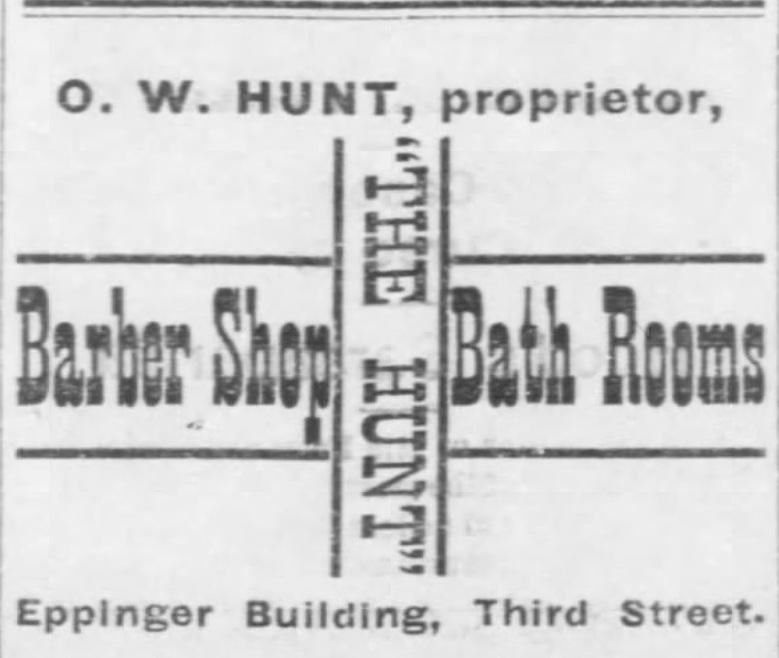
“The Hunt”, O. W. Hunt proprietor, offers Bath Rooms in his Barber Shop. Advertised in Burlington Republican of Burlington, Kansas. July 12, 1888.
.

“Baths and Barber Shop” advertised, alongside Prof J. H. Baldridge, a tonsorial physiognomical hair cutter, “banging ladies’ hair a specialty.” Both in Statesman Journal of Salem, Oregon. May 23, 1886.
.
What Did Old West Barbers Charge?
.
“Shave and a hair cut, two bits?“
.

Prices for barber services are apparently falling. Fort Scott Daily Monitor of Fort Scott, Kansas, on March 8, 1870.
.
Price Comparison
.
$0.10 of 1870 dollars would be worth: $1.82 in 2015 (latest year available)
$0.20 of 1870 dollars would be worth: $3.64 in 2015
$0.25 of 1870 dollars would be worth: $4.55 in 2015
$0.40 of 1870 dollars would be worth: $7.27 in 2015
.
How they Shave in China
.
Who knows if this 1872 newspaper report is accurate? Isn’t it curious to see what services are included by this Chinese barber:
- Shave with no lather
- Ear cleaning with a needle shaped spoon
- “Cracking” of the neck
- Neck pounding (massage)
.

1 of 2: Chinese shave. Osage County Chronicle of Burlingame, Kansas on September 6, 1872.
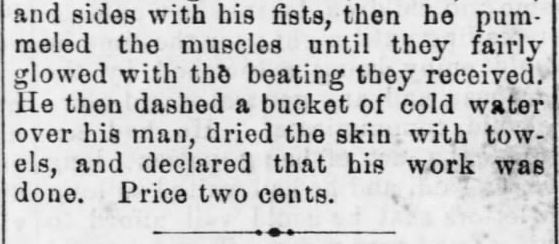
2 of 2: Chinese shave. Osage County Chronicle of Burlingame, Kansas on September 6, 1872.
.
Given this supposed report costs two cents (about 40 cents now), I suggest this is an example of racial stereotyping. Quite typical for the mid- and late-nineteenth century.
.
Price Comparison
.
$0.02 of 1872 dollars would be worth: $0.39 in 2015 (latest year available)
.
Old West Barbers Were Men (females in the business caused quite a stir!)
.

Detroit has female barber, published in The Emporia Weekly News of Emporia, Kansas on January 21, 1870.
.

1 of 3: Four Girl Barber. The Sedalia Weekly Bazoo of Sedalia, Missouri, on October 23, 1883.
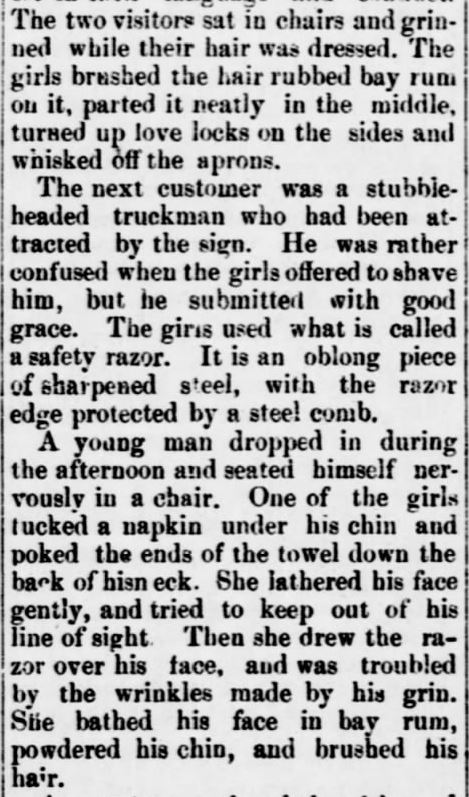
2 of 3: Four Girl Barbers. The Sedalia Weekly Bazoo of Sedalia, Missouri, on October 23, 1883.

3 of 3: Four Girl Barbers. The Sedalia Weekly Bazoo of Sedalia, Missouri, on October 23, 1883.
.

Victorian Poem: The Lady Barber. Published in Hamilton Evening Journal of Hamilton, Ohio. August 16, 1894.
.
The Barber’s Trade
.

Moler’s Barber College (St. Louis or Denver) teaches the Barber Trade. Published in The Topeka State Journal of Topeka, Kansas on November 27, 1901.
.
In a book titled Barber Instructor and Toilet Manual, published in 1900 (now in the public domain) by Frank C. Bridgeford, the author cites reasons why the the Barber’s choice of professions is a life calling:
.
There are few trades offering better inducements than that of the barber. Everywhere in the civilized wo[r]ld [sic] he readily finds employment. It is not at all likely that the barbers trade will to any great extent ever be interfered with by machinery. The barber commands a good salary and steady imployment [sic]. He is constantly surrounded by the current news of the day and always has time to read and keep abreast with the progress of the world. Barbers wages in the United States run from ten to eighteen dollars a week, owing to locality and other conditions. [sic] (all punctuation, spelling, and formatting directly transcribed from the historic book)
.
~ Barber Instructor and Toilet Manual, 1900, by Frank C. Bridgeford
.
Price Comparison
.
$10 of 1900 dollars would be worth: $285.71 in 2015 (latest year available), per week salary, = roughly $1142.00 per month
.
$18 of 1900 dollars would be worth: $514.29 in 2015 (latest year available), per week salary, = roughly $2057.00 per month
.
.
Related Articles
.
.
Updated May 2022
Copyright © 2016 Kristin Holt LC
Old West Barber Shop Old West Barber Shop







